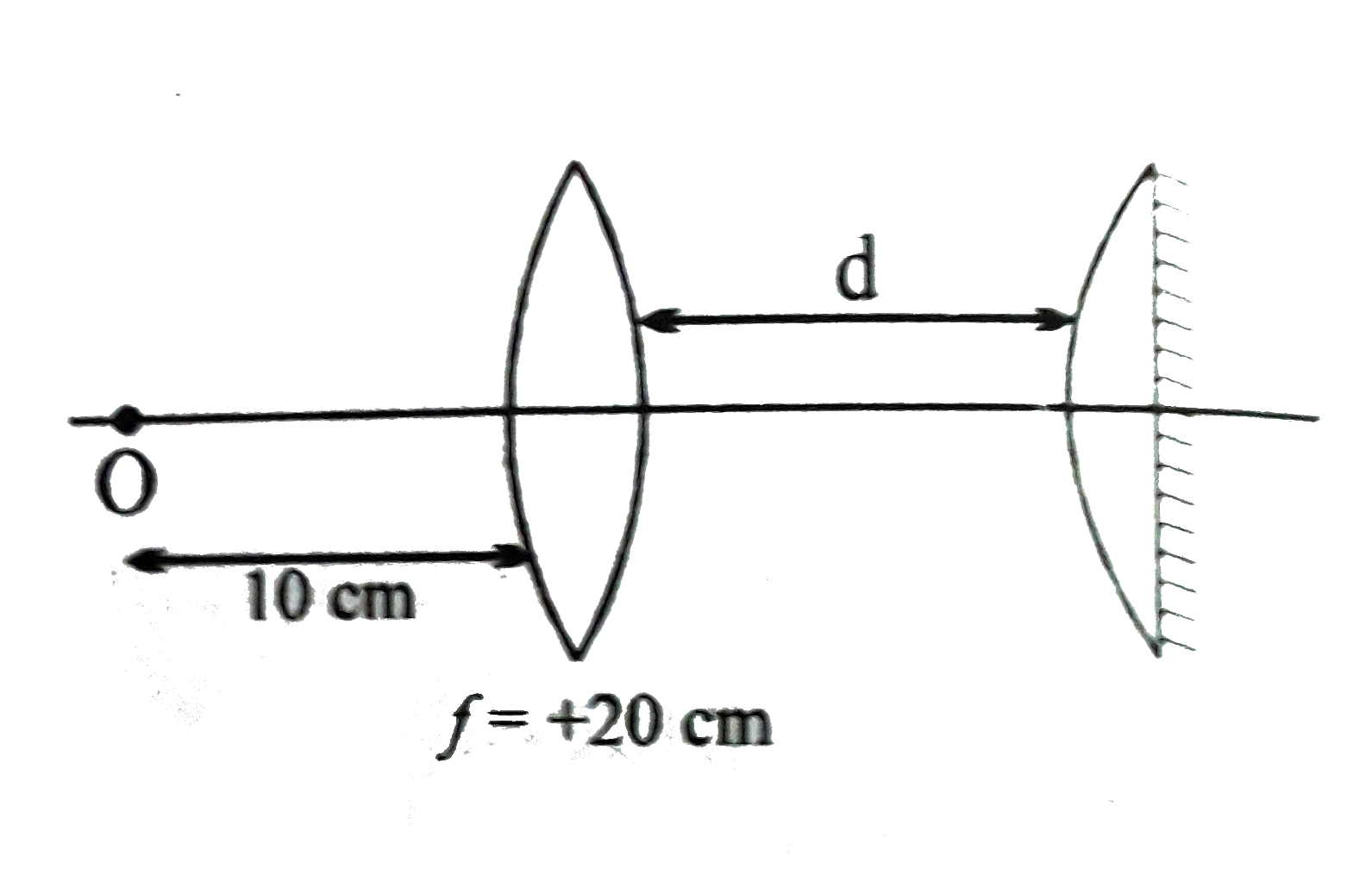A diverging lens of focal length 20 cm and a converging mirror of focal length 10 cm are placed coaxially at a separation of 5 cm. Where should an object be placed so that a real image is formed at the object itself ?
The correct Answer is:A, C
To solve the problem, we need to find the position of the object such that a real image is formed at the position of the object itself when a diverging lens and a converging mirror are placed coaxially with a separation of 5 cm.
1. Identify the Focal Lengths:
- The focal length of the diverging lens (concave lens) is given as fL=−20cm.
- The focal length of the converging mirror (concave mirror) is given as fM=−10cm (using the sign convention).
2. Set Up the Problem:
- Let the object distance from the lens be uL=−x (negative because the object is on the same side as the incoming light).
- The distance between the lens and the mirror is d=5cm.
3. Apply the Lens Formula:
The lens formula is given by:
1vL−1uL=1fL
Substituting the values:
1vL−1−x=1−20
Rearranging gives:
1vL=1−20−1−x=−120+1x
Thus,
vL=−20x20+x
4. Determine the Object Distance for the Mirror:
The object distance for the mirror uM is the distance from the mirror to the image formed by the lens:
uM=−(d+vL)=−(5+−20x20+x)
Simplifying this:
uM=−(5−20x20+x)=−(5(20+x)−20x20+x)=−(100+5x−20x20+x)=−(100−15x20+x)
5. Apply the Mirror Formula:
The mirror formula is given by:
1vM+1uM=1fM
Substituting the values:
1vM−20+x100−15x=−110
Rearranging gives:
1vM=−110+20+x100−15x
6. Final Image Position:
Since we want the final image to be at the object position, we set vM=x:
1x=−110+20+x100−15x
Cross-multiplying and simplifying will yield a quadratic equation in x.
7. Solve for x:
After solving the equation, we find:
x=60cm
Conclusion:
The object should be placed at a distance of 60 cm from the lens.
- The focal length of the diverging lens (concave lens) is given as fL=−20cm.
- The focal length of the converging mirror (concave mirror) is given as fM=−10cm (using the sign convention).
- Let the object distance from the lens be uL=−x (negative because the object is on the same side as the incoming light).
- The distance between the lens and the mirror is d=5cm.
The lens formula is given by:
1vL−1uL=1fL
Substituting the values:
1vL−1−x=1−20
Rearranging gives:
1vL=1−20−1−x=−120+1x
Thus,
vL=−20x20+x
The object distance for the mirror uM is the distance from the mirror to the image formed by the lens:
uM=−(d+vL)=−(5+−20x20+x)
Simplifying this:
uM=−(5−20x20+x)=−(5(20+x)−20x20+x)=−(100+5x−20x20+x)=−(100−15x20+x)
The mirror formula is given by:
1vM+1uM=1fM
Substituting the values:
1vM−20+x100−15x=−110
Rearranging gives:
1vM=−110+20+x100−15x
Since we want the final image to be at the object position, we set vM=x:
1x=−110+20+x100−15x
Cross-multiplying and simplifying will yield a quadratic equation in x.
After solving the equation, we find:
x=60cm
The object should be placed at a distance of 60 cm from the lens.
Topper's Solved these Questions
- BOOK - HC VERMA ENGLISHCHAPTER - GEOMETRICAL OPTICSEXERCISE - EXAMPLE9videos
GEOMETRICAL OPTICS
- BOOK - HC VERMA ENGLISHCHAPTER - GEOMETRICAL OPTICSEXERCISE - Question For short Answer18videos
GEOMETRICAL OPTICS
- BOOK - HC VERMA ENGLISHCHAPTER - GEOMETRICAL OPTICSEXERCISE - Objective -27videos
GEOMETRICAL OPTICS
- BOOK - HC VERMA ENGLISHCHAPTER - GAUSS LAWEXERCISE - Short Question7videos
GAUSS LAW
- BOOK - HC VERMA ENGLISHCHAPTER - LIGHT WAVESEXERCISE - Question for short Answer11videos
LIGHT WAVES
Similar Questions
A converging lens of focal length 12 cm and a diverging mirror of focal length 7.5 cm are placed 5.0 cm apart with their principal axes coinciding. Where should an object be placed so that its image falls on itself ?
View SolutionA diverging lens of focal length 20 cm and a converging lens of focal length 30 cm are placed 15 cm apart with their principal axes coinciding. Where should an object be placed on the principal axis so that its image formed at infinity ?
View SolutionA converging lens of focal length 15 cm and a converging mirror of focal length 10 cm are placed 50 cm apart. If a pin of length 2.0 cm is placed 30 cm from the lens farther away from the mirror, where will the final image form and what will be the size of the final image ?
View SolutionA converging lens of focal length 20 cm and a converging mirror of focal length 10 cm are placed 60 cm apart with common principal axis. A point source is placed in between the lens and the mirror at a distance of 50 cm from the lens. Find the locations of the images formed.
View SolutionA converging lens of focal length 15 cm and a converging mirror of focal length 10 cm are placed 50 cm apart with common principal axis. A point source is placed in between the lens and the mirror at a distance of 40 cm from the lens. Find the locations of the two images formed.
View SolutionA point source S is placed at a distance of 15 cm from a converging lens of focal length 10 cm on its principal axis. Where should a diverging miror of focal length 12 cm be placed to that a real image is formed on the source itself.
View SolutionAn object is placed 40 cm from a concave mirror of focal length 20 cm. The image formed is
View SolutionAn upright object is placed at a distance of 40cm in front of a convergent less of focal length 20cm. A convergent mirror of focal length 10cm is placed at a distance of 60cm on the other side of the lens. The position and size of the final image will be:
View SolutionA convex lens of focal length 20cm and another plano convex lens of focal length 40cm are placed co-axially . The plano convex lens is silvered on plane surface. What should be the distance (in cm) so that final image of the object 'O' is formed on O itself.
 View Solution
View SolutionThe focal length of a concave mirror is 50cm. Where an object be placed so that its image is two times and inverted
View Solution

